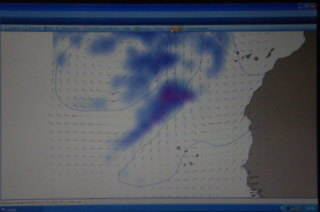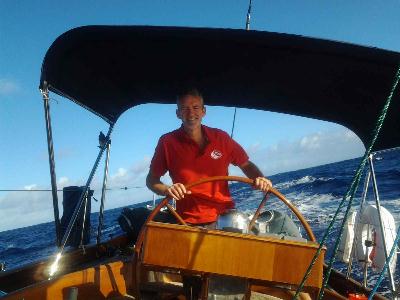In what can only be described as an “interesting” weather scenario, the ARC passage to Saint Lucia has seen the fleet split into two unequal halves, as predicted at the pre-start briefing, but has now become three halves! How can that be?
ARC weatherman Chris Tibbs briefed captains before departure about a developing low in the north Atlantic, which would be the dominant feature for the first part of the crossing. Many of the racing skippers, especially those on the large or fast boats, were excited by this news, as it opened the door to the longer “northern route” and the prospect of record breaking crossing times. If any of the racing boats could sail sufficiently far north, and fast enough, then they would be able to sail down the western side of the low, and take advantage of strong winds and excellent sailing angles to power towards Saint Lucia.
This is a risky strategy, as they low could move north faster than predicted and could deepen to become a sub-tropical storm. However, for Caro and Monster Project, it looks like their gamble may have worked, as they are now sailing off the back of the low and are being rewarded with speeds in double figures.
But the ARC is a cruising rally, and most captains followed Chris’ advice, which was to take a more cautious route close to the Cape Verde Islands, before heading west across the Atlantic. This is the route jokingly referred to as “sail south until the butter melts”! However, with the developing low several hundred miles away disturbing the trade wind air flow, this route option looked likely to mean lots of light winds and plenty of motoring hours early on.
 Now, by a quirk of the weather, our two halves of the fleet have become three parts as the southern route has in turn been split by an unusual weather pattern. A trough of low pressure, associated with the gale system to the north, has formed a line of intense squall activity, stretching along the rhumb line route to Saint Lucia. Those boats sailing the rhumb line course have been experiencing 24 hours of head winds and gale conditions, with some crews describing the rain as of “biblical proportions”. However, this weather system is so elongated and localised, that boats as little as sixty miles away have had little or no winds, and have had to motor to make way south. So much so that 15 boats have already called into Marina Mindelo in the Cape Verdes islands to refuel.
Now, by a quirk of the weather, our two halves of the fleet have become three parts as the southern route has in turn been split by an unusual weather pattern. A trough of low pressure, associated with the gale system to the north, has formed a line of intense squall activity, stretching along the rhumb line route to Saint Lucia. Those boats sailing the rhumb line course have been experiencing 24 hours of head winds and gale conditions, with some crews describing the rain as of “biblical proportions”. However, this weather system is so elongated and localised, that boats as little as sixty miles away have had little or no winds, and have had to motor to make way south. So much so that 15 boats have already called into Marina Mindelo in the Cape Verdes islands to refuel.
Alistair on Free Spirit described the experience of the weather system in his blog. “It’s been a tough past 24 hours, with winds through Friday night climbing to low 20 with persistent rain. As the winds picked up through Saturday morning, rain intensified, and we then hit a very severe squall line moving north-east up the Atlantic. Our max wind measurement was 42 knots, and we had about 20 minutes in the high 30s. Lightening was flashing around us, and the sea state changed, with the peaks of the chop over the 4 - 5m swell being blown off into a spray by the strong wind, and beaten down by the rain, visibility was very minimal!”

Now clear of the squall lines, the sun has come out, and at last the butter is beginning to melt. Mark on Keoma writes today in his blog “Now rewarded with fabulous sailing, big spinnaker went up at first light and we are bowling along at 8.5knts 15-18knts of wind in moderate sea, just passed 1000 miles on our trip log.”
Boats on or to the north of the rhumb line can still expect several days of reducing headwinds as the system passes, but will be able to make westing. Those in the latitudes of the Cape Verdes are falling into the trade wind belt and can expect some sunshine downwind sailing as they head towards Saint Lucia.